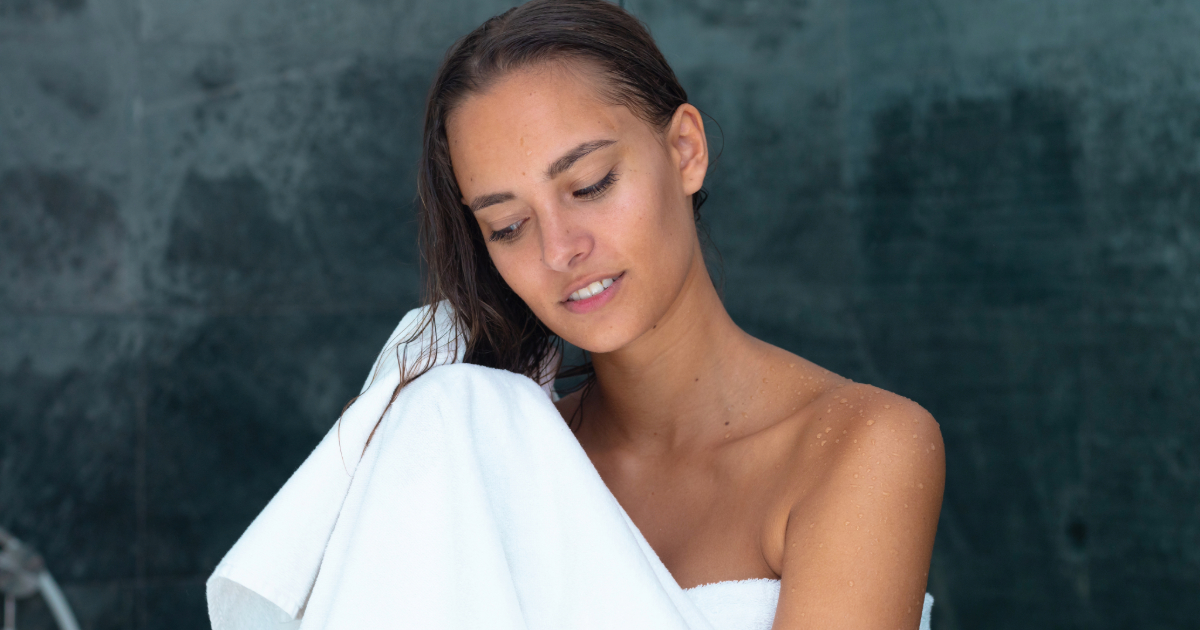When you step out of the shower, your hair is dripping wet. Reaching for the nearest towel or t-shirt to soak up the moisture is second nature. But have you considered which is better for your hair health – a regular towel or an old t-shirt?

The texture and fibers of different fabrics can impact your hair very differently. Using the wrong material can damage your hair, causing more frizz, split ends, and breakage over time. That’s why it’s important to understand the pros and cons of towels versus t-shirts for drying those wet locks.
Why Regular Towels Can Damage Hair
For many years, people have used regular towels after every shower to dry their hair. The towels may get the job done in soaking up moisture, but they can take a real toll on your hair health.
The main reason is that towels can be too rough and cause friction damage. Towels are made from materials like terry cloth or cotton. These fabrics have loops or piles that create that ultra-absorbent texture. However, those same loops also catch on to the strands of your hair.
As you rub the towel over your hair to dry it, the hooks of the towel latch onto your hair and don’t let go easily. This puts tension on your hair strands, forcing them to stretch farther than they should. Some may simply come unhooked from the towel, but the force can break hair strands or pull them out of the follicle.
Over time, this friction and breakage can really damage your hair. You may notice more frizz, split ends, shorter length, or even thinning. It strips away your hair’s natural oils and smooth cuticle layer too. Your once-healthy hair ends up dry, dull, and fragile.
Clearly, there must be a better way!
Key Takeaway: The rough texture of towels grabs onto hair strands, causing tugging, friction, and breakage.
Advantages of Using a T-Shirt
If regular towels are too harsh for delicate wet hair, then what about opting for an old cotton t-shirt instead?
The fabric of a (100% cotton) t-shirt has some advantages:
- Softer texture – Cotton t-shirts typically have a softer, smoother surface rather than terry cloth loops.
- Less friction – The soft fabric doesn’t latch onto hair strands as aggressively. This causes less pulling and friction damage.
- Absorbent – The cotton material still soaks up excess moisture without over-drying.
- Gentle – A t-shirt is less likely to cause breakage, allowing hair to air dry smoothly.
Switching to a t-shirt takes just a few simple adjustments to your regular hair drying routine.
Here’s a step-by-step guide on how to dry your hair with a t-shirt:
- Shampoo and condition your hair as normal in the shower. Rinse out any residual conditioner under cool water.
- Gently squeeze out any excess dripping water from the ends using your hands.
- Flip your head upside down. Scrunch hair to soak up moisture with a clean, 100% cotton t-shirt. Avoid scrubbing or friction.
- Carefully smooth your hair back so the ends hang down into the t-shirt’s neck hole. Pull the rest of the shirt up and over your head.
- Wrap up your hair by twisting and crossing the sleeves or bottom of the t-shirt at the nape of your neck if needed.
- Leave the t-shirt wrapped turban-style for at least 10 minutes, or up to 30 minutes for thick hair. This lets it air dry without full towel friction.
- Unwrap the t-shirt and gently style as desired – adds products, brush, blow dry gently using cool air/heat protectant, etc.
The t-shirt method helps minimize damage by cradling your hair and letting it dry naturally. Air drying avoids additional heat damage too.
With this technique, you may find your hair overall becomes shinier, smoother, and more manageable. Many people with curly or textured hair find this method enhances their natural curl pattern as well.
Now let’s look at another popular hair drying option: the microfiber towel. How does it compare to t-shirts?
Microfiber Hair Towels
Microfiber towels have exploded in popularity in recent years as a hair drying alternative. But what makes them different than regular towels or t-shirts?
The defining feature of microfiber is the tiny, gentle fabric fibers. While the loops of terry cloth towels are large and abrasive, microfiber strands are 100 times finer than a human hair.
Despite the small size, these fibers are woven tightly so the towel is still very absorbent. The lightweight microfiber also dries hair faster than a regular towel.
Here is a comparison of the potential pros and cons of microfiber hair towels:
| Pros | Cons |
|---|---|
| Ultra-fine strands don’t damage hair | Some lower-quality microfiber still pulls hair |
| Smoother surface | Fibers may be too rough without proper quality controls |
| Very absorbent | Can potentially over-dry hair |
| Dries hair fast | Not as soft as high-quality cotton tee |
| Enhances natural curls |
As you can see, high-quality microfiber offers many of the same gentler hair drying benefits as a t-shirt. However, not all microfiber towels live up to these promises.
The quality of the microfiber can vary greatly between brands and price points.
Some cheap versions still have fibers that are too large and rough. This can negate any benefits for your hair, causing the same friction, tugging and breakage issues as terry cloth towels.
When first experimenting with a microfiber towel, pay attention to how it feels on your delicate wet hair. If it ever pulls or seems to “stick” as you work it over your strands, it could be damaging hair. Discontinue use immediately.
Key Takeaway: With microfiber hair towels, quality matters. Seek smooth, ultra-fine strands rather than large catchy loops.
See the table below highlighting what to look for in a quality microfiber hair towel:
| Good Microfiber Hair Towel | Bad Microfiber Hair Towel |
|---|---|
| Ultra-smooth, soft texture | Rough, scratchy texture |
| Tiny, woven fibers | Large, looped fibers |
| Glides easily over hair | Catches, pulls hair strands |
| Gentle friction | High friction causes breakage |
| Absorbs moisture without over-drying | May strip hair’s natural oils |
With so many options for drying your hair, it can be tricky to know where to start. But now that you understand the unique textures and how they impact your hair, you can make the choice that best suits your hair type and texture.
Which Is Better: Towel, T-Shirt or Microfiber?
When it comes to drying your hair with minimal damage, towels are out. The loops and piles cause too much breakage over time.
Both t-shirts and microfiber hair towels offer a gentler alternative. But which method comes out on top?
For most hair types, 100% cotton t-shirts seem to provide the best friction-free drying for healthy hair. The soft, woven cotton cradles hair without damage. It’s accessible and budget-friendly too.
However, ultra high-quality microfiber towels can yield similar benefits. Their tiny size allows the towels to absorb lots of water without tugging on strands. Just be sure any microfiber has the proper fine, smooth texture.
There’s no need to over-complicate things. Whichever method you gravitate towards naturally will help you build a regular gentle hair drying habit. Consistency is key for improving hair health over time.
Still not sure where to start? Here are some final hair-saving tips:
- Always handle wet hair gently – Regardless of drying method, be extremely delicate with fragile wet hair. Avoid scrubbing, rubbing and friction from towels, shirts or your own hands.
- Try both options – Experiment with cotton tee drying and smooth microfiber towels. See which feels best and yields the highest shine/definition.
- Air dry when possible – Let hair dry fully before manipulating or styling to prevent extra breakage. Air drying is gentler than any rubbing.
- Ask a stylist – If you’re unsure which method is best for your hair type, ask your hairstylist for personalized recommendations on reducing damage from drying.
Whichever gentle drying method you land on, consistency is key for keeping hair happy and healthy. Say “no” to towels, “yes” to being kind to your strands, and your hair will thank you!
FAQs
Why not use a cotton pillowcase instead of an old t-shirt?
The cotton used in most pillowcases, sheets, and even some clothing has a much rougher, more abrasive texture compared to high quality t-shirts. So while a pillowcase seems similar to a tee, it can actually damage hair more akin to a towel. Stick with an old 100% cotton t-shirt specifically for gentle hair drying purposes.
Can I use a microfiber towel on wet hair if I have chemically treated or colored hair?
Yes, a smooth high quality microfiber towel may be used on colored, bleached, relaxed, or otherwise chemically treated hair. However, keep in mind that any hair drying method (towel, t-shirt, air dry, etc) should be extremely gentle with processed hair. The fibers have been altered and may have more damage, so handle very delicately when wet to prevent excess breakage or color stripping.
What about silk or satin: are those materials good for drying hair?
Materials like silk and satin make excellent gentle hair wraps to protect your hair at night or preserve styles. However, silk and satin fabrics don’t actually absorb much moisture. So while they won’t damage hair, they won’t dry it much either. Stick with cotton t-shirts or microfiber hair towels specifically designed to absorb excess water.
Can I regularly use a towel or t-shirt to dry my wet hair?
You’ll want to minimize damage by being extremely gentle whenever drying fragile wet hair. However, you likely need to routinely wash and dry your hair as part of a healthy hair care regimen. Regular gentle drying with a t-shirt or proper microfiber towel won’t ruin your hair. Just be sure to handle strands lightly to prevent excess friction over time, and avoid tugging or scrubbing motions.
Conclusion
Drying your hair properly after each wash makes a huge difference in keeping your strands healthy. Avoiding damage from friction means being mindful of your choice of hair drying fabrics.
While many people automatically reach for a towel, it’s worth considering if an old cotton t-shirt or microfiber hair towel would be gentler on your hair type instead. Saving your strands now prevents extra breakage and splits down the road.








